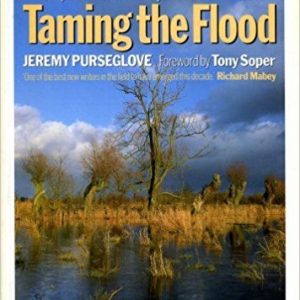Taming The Flood – a new book

In Jeremy Purseglove’s newly available edition of ‘Taming the Flood’, the environmentalist reflected on harnessing nature rather than attempting to supress it, in regards to facing the environmental disasters which pose threat to us today. Purseglove, who works as a practical landscape architect and ecologist beneath the water industry, has undertaken active involvement in land drainage engineering which attempts to enhance, rather than destroy, the heritage of Britain’s rivers and wetlands.
The book has received outstanding reviews, in that the eloquently written update stands as a call for action in a time when most needed. Sir Peter Scott, in reviewing the first edition, described it as “a most authoritative book which appears at a very appropriate time. It will give rise to new attitudes in an extremely important aspect of conservation, and new hope to those who are fighting for a more enlightened approach to wetlands”. Purseglove reflects heavily upon the natural history of our rivers and wetlands, from the Lancashire mosses and the Derwent Ings, Otmoor and the Fens, to Romney Marsh and the Somerset Levels – placing emphasis on the importance of heritage and conservation of this. Reference to this seems timely in light of the colossal degradation of natural areas such as wetlands which has accelerated in recent years. For instance, recent studies undertaken by George Heritage prove that near 90% of English wetlands are now damaged beyond the point of restoration, largely due to urbanisation, agricultural interference, or as what Purseglove describes as “the often disastrous attempts to tame them”.
Purseglove steers us away from damaging practices that have for so long weakened the surrounding environment, and instead highlights flood resilience methods such as reedbed flood alleviation systems or drainage lagoons incorporated into highways and residential developments. Bruce Keith, being the president and trustee of CIWEM, explained in his review of the book that “the proper legislation, policy measures and codes of practice need to be in place to promote integrated land and water management”, yet this remains hard to come by. He went on to explain that “a wider, more holistic approach is required” in flood risk management, or ‘taming’ the floods.
Insurance Business Magazine recently reflected on this very idea in light of the property chain, in that “various participants” – such as local authority planners, government, housebuilders, data providers and insurers – should all play a part in more “holistic flood resilience, building design and physical protection measures”. They also placed emphasis on “educating consumers”, who often lack knowledge on the subject of flood risk. For instance using an online map view of flood risk in an area can give instant insight on a building’s vulnerability to flooding, while further information can be obtained from often overlooked sources – such as the Environment Agency.
All in all Purseglove’s ‘Taming the Flood’ can not only be seen as a reflection on the importance of protecting our heritage, but also stands as a call for action and education in protecting the delicate landscapes which fall vulnerable to human intrusion.
If you are interested in obtaining a Flood Risk Assessment, whether it be for planning, marketing, or insurance purposes, do not hesitate to contact us here at UNDA for further information.